|
ASPCA Believes Fear of Acetaminophen-contamination
in Pet Food Unfounded:
Organization Cites Independent Testing by UC-Davis in Addition
to Earlier FDA Test Results
 NEW
YORK-In light of the recent Menu Foods pet food recall, recent
speculation on whether certain pet foods may be contaminated
with acetaminophen has been spreading alarm among pet parents
and the public. NEW
YORK-In light of the recent Menu Foods pet food recall, recent
speculation on whether certain pet foods may be contaminated
with acetaminophen has been spreading alarm among pet parents
and the public.
The ASPCA® (The American Society for the Prevention of Cruelty
to Animals®) today announced that it has been in close touch
with veterinary toxicologists at the University of California
(Davis), who have conducted independent tests on cat food to
analyze for this contaminant-and whose findings corroborate those
of the U. S. Food and Drug Administration (FDA), as cited in
the press. As such, the ASPCA believes that fears of widespread
contamination of pet food with acetaminophen are unfounded.
"Ever since the news broke that some pet food had been found
to have been contaminated with acetaminophen, we were justifiably
concerned for the continuing safety of pets," said Dr. Steven
Hansen, a board-certified veterinary toxicologist and senior
vice president with the ASPCA, who manages the ASPCA's Animal
Poison Control Center (APCC), located in its Midwest Office in
Urbana, Ill. "As we mentioned in our last advisory, acetaminophen
poisoning can be deadly in pets, especially cats."
Dr. Robert H. Poppenga, a board-certified veterinary toxicologist
and who runs the Toxicology Section of the California Animal
Health and Food Safety System at UC Davis' School of Veterinary
Medicine, explained further. "A few weeks ago, CAHFS received
three cans of cat food supplied to it for testing by an individual
pet owner. We were told that this was the same food that had
tested positive for acetaminophen and cyanuric acid at a private
laboratory in Texas. Further, the cat in question had been diagnosed
with acute renal failure, but there was no evidence of liver
failure, which is what we see with acetaminophen poisoning."
"We immediately began conducting our own rigorous tests
on these foods, which are in line with nationally-accepted guidelines
for such testing. All the samples came back negative for this
type of contamination."
Continued Dr. Hansen, "The bottom line is that neither did
the FDA's tests confirm the presence of acetaminophen, nor those
conducted by UC-Davis-nor has the APCC managed any clinical
cases to date."
"As a result, we want to reassure the public that, based
on this information, we believe any fear of acetaminophen contamination
in pet food is unfounded, and pet parents should rest easy on
that account."
The ASPCA continues to monitor developments in the Menu Foods
recall situation and related information, and is providing regular
updates and advice for pet parents, at its Pet Food Recall Resource
Center at www.aspca.org/recall.
Hear this and other breaking news as it happens - Animal Radio® is streaming online 24/7 Listen LIVE Now!
Star-Studded
Summer on Animal
Radio®

Kenny Kingston, Psychic to the Stars, was the personal reader of Marilyn
Monroe and has read for Greta Garbo and Whoopi Goldberg, to name
a few. Joining Kingston is Dr. Joyce Brothers who
talks about pets and relationships, actor Leslie Nielsen
and Gary Burghoff of M*A*S*H.
Quick-links:
- Kenny Kingston, Psychic to the Stars, still
speaks with Lucille Ball on a regular basis. He has an
affinity for the furry. LISTEN
- Dr. Joyce Brothers discusses how pets come between partners.
LISTEN
- Leslie Nielsen never leaves home without his "animal."
LISTEN
This Week on Animal Radio®:
Leslie Nielsen
 Since
Leslie is always on the go, he currently does not have any pets,
as he feels it wouldn't be fair to them. But, his one "Animal"
that he never leaves home without is his "Whoopee Cushion."
Hear him talk about some of his greatest moments with his "animal." Since
Leslie is always on the go, he currently does not have any pets,
as he feels it wouldn't be fair to them. But, his one "Animal"
that he never leaves home without is his "Whoopee Cushion."
Hear him talk about some of his greatest moments with his "animal."
Look for Leslie in the upcoming
release of "Music Within, " the true story of Richard
Pimentel, a brilliant public speaker with a troubled past, who
returns from Vietnam severely hearing -impaired and finds a new
purpose in his landmark efforts on the behalf of Americans with
disabilities, as well as "Scary Movie 5." And could
there be a spoof of Spider Man in the works? Tune in to find out.
Gary Burghoff - Corporal "Radar" O'Reilly of M*A*S*H
 Gary Burghoff and "Radar"
O'Reilly are synonymous with the kind, lovable yet kindred spirits
we can all remember with fondness. The role of "Radar"
was tailor-made for Gary because of his obvious love of animals
and his extraordinary personality. Remember Radar's zoo in M*A*S*H?
This theme originated from his real life Animal Rehabilitation
Clinic in Southern California where he nurtured and cared for
many species of birds such as the brown pelican, and many other
animals including opossums, grey squirrels, raccoons and abandoned
creatures needing Gary's special and tender-loving care. In fact
Gary, once known as the "Bird Man of Malibu", was licensed
by the State of California to care for wounded animals. Listen in Real Audio 6/30-7/4 Gary Burghoff and "Radar"
O'Reilly are synonymous with the kind, lovable yet kindred spirits
we can all remember with fondness. The role of "Radar"
was tailor-made for Gary because of his obvious love of animals
and his extraordinary personality. Remember Radar's zoo in M*A*S*H?
This theme originated from his real life Animal Rehabilitation
Clinic in Southern California where he nurtured and cared for
many species of birds such as the brown pelican, and many other
animals including opossums, grey squirrels, raccoons and abandoned
creatures needing Gary's special and tender-loving care. In fact
Gary, once known as the "Bird Man of Malibu", was licensed
by the State of California to care for wounded animals. Listen in Real Audio 6/30-7/4
Next Week on Animal
Radio®:
Lucie Arnaz
  Lucie Arnaz was an early
member of Actors and Others for Animals when they opened their
doors in 1971. The offspring of Lucille Ball and Desi Arnaz,
discusses her childhood pets and life with her famous parents. Lucie Arnaz was an early
member of Actors and Others for Animals when they opened their
doors in 1971. The offspring of Lucille Ball and Desi Arnaz,
discusses her childhood pets and life with her famous parents.
Lucie has several movies to
her credit, but her real passion lies in live theatre. You can
catch her live performance at "Broadway at Birdland"
at Birdland in New York, July 15th & 16th.
Therapy
Kangaroo
 A
Baby Kangaroo Is Helping Residents of a Senior Citizens Community.
The residents of one senior center are getting a hopped-up dose
of medicine. A
Baby Kangaroo Is Helping Residents of a Senior Citizens Community.
The residents of one senior center are getting a hopped-up dose
of medicine.
But they're not popping pills,
they're spending quality time with Elliot, a 6-month-old kangaroo
that is one of the most popular members of this senior living
community.
Elliot hops the halls, mingling
with the 120 seniors suffering from Alzheimer's disease and Parkinson's
disease.
RECENT Animal Radio® PODCASTS:
  Podcast
NFL STAR INVESTIGATED FOR DOG FIGHTING - HSUS Pres. WAYNE
PACELLE (1 hour abridged version) Podcast
NFL STAR INVESTIGATED FOR DOG FIGHTING - HSUS Pres. WAYNE
PACELLE (1 hour abridged version)
Podcast
DR. JOYCE BROTHERS - Your spouse and your pet (1
hour abridged version)
Podcast
KENNY KINGSTON - Legendary psychic loves sweet animal
spirits too! (1 hour abridged version)
Podcast
JILL MARIE COMBINE - Celebs and their pets. What's up
with Paris Hilton's Tinkerbell? (1 hour abridged version)
Podcast
LESLIE NIELSEN, Mr. Magoo, Scary Movie, Naked Gun, Animal
Radio® (1 hour abridged version)
Podcast
SUMMERTIME ALLERGIES AFFECT PETS TOO (1 hour abridged
version)
Recently on Animal
Radio®:
Kenny Kingston - Psychic
to the Stars
 Many
of you know legendary psychic Kenny Kingston, the original 'Psychic
to the Stars.' Many
of you know legendary psychic Kenny Kingston, the original 'Psychic
to the Stars.'
Kenny Kingston was the personal
reader of Marilyn Monroe and has read for Lucille Ball, Greta
Garbo and Whoopi Goldberg, to name only a few of Kenny's famous
clientele.
He is here to answer your questions
about your pet. Yes, your pet! We go to the phones and conference
your calls this week.
http://www.KennyKingston.org
 Hear Kenny Kingston
on Animal Radio® Hear Kenny Kingston
on Animal Radio®
Kids Learn about Pets with
Handicaps
 What started as
a class project for fourth-graders learning about handicapped
pets turned into a nationwide effort to help a bright-eyed dachshund
left partially paralyzed after an attack by angry teens. What started as
a class project for fourth-graders learning about handicapped
pets turned into a nationwide effort to help a bright-eyed dachshund
left partially paralyzed after an attack by angry teens.
Kathy Barton's 4th grade class
in Velma, Oklahoma, was working with HandicappedPets.com to create
awareness of the value of disabled animals. They heard about
the plight of a dachshund in Tennessee named "Boo,"
now named "Johanna" and wanted to help. The dog had
been attacked with a bat and was left paralyzed in her rear legs
and incontinent. After her injury, her former owner would chain
her outside to prevent damage to the rugs. To move around, she
had to drag around her back legs in the dirt, leaving them scraped
and raw. Their class project became a successful rescue mission.
 Every year since then, Kathy Barton's
4th grade class learns about handicapped pets and raises money
to help buy carts for these animals. This year, they helped raised
enough money through fundraisers to purchase 3 carts, one for
a quadriplegic cat, (see the Video) Every year since then, Kathy Barton's
4th grade class learns about handicapped pets and raises money
to help buy carts for these animals. This year, they helped raised
enough money through fundraisers to purchase 3 carts, one for
a quadriplegic cat, (see the Video)
http://www.handicappedpets.com/news/inthenews.html
And 2 others for two dogs unable to walk.
http://www.HandicappedPets.com
 Hear about Kathy's
4th grade class on Animal Radio® Hear about Kathy's
4th grade class on Animal Radio®
 When Pets Come Between Partners When Pets Come Between Partners
Dr. Joyce Brothers
Real trouble can start
when pets get in the way in bed. Many divorces site this as a
primary problem. Dr. Joyce Brothers is a noted psychologist,
columnist, author and one of America's 10 most influential women.
Hear
what Brothers has to say about pets coming between partners.
She answers the questions about pets in bed with you and your
spouse, whether or not people start to look like their pets,
and a whole bunch of things you've always wondered, but were
waiting for Animal
Radio® to ask.
 DOES YOUR PET SLEEP IN BED WITH
YOU? See
the stats! DOES YOUR PET SLEEP IN BED WITH
YOU? See
the stats!
 Hear Dr. Joyce
Brothers on Animal Radio® Hear Dr. Joyce
Brothers on Animal Radio®
Will Your Microchip Become Outdated?
Mike Fry, Animal
Ark Animal Shelter and Host of Animal Wise Radio with Dr. Linda
Wolf
Microchipping is a procedure where a small microchip is embedded
under your pet's skin, so that if Fido or Fluffy or Tweety become
separated from their loving owners, the chip can be scanned and
the chip registration company can be contacted and you can all
be happily reunited.
But, here's one of the major
problems with the microchipping industry. Too many cooks spoil
the broth. There are now so many companies that have entered
the microchip business, developing chips with different frequencies.
And these differing microchip frequencies require scanners that
pick up all of those different frequencies. So what happens if
a shelter or veterinary office or research facility has a scanner
that doesn't read your pet's chip? The animal gets listed as
not having a microchip.
 Hear
Dr. Linda Wolf on Animal Radio® Hear
Dr. Linda Wolf on Animal Radio®
Beer for Dogs
 Mike
Fry, Animal Ark Animal Shelter and Host of Animal Wise Radio
with Dr. Linda Wolf Mike
Fry, Animal Ark Animal Shelter and Host of Animal Wise Radio
with Dr. Linda Wolf
Beer for dogs, what next? Perhaps your dog prefers the taste
of a nice cold beer after a hard day of laying around, or maybe
he just wants to drink out of the toilet!
 Hear
Dr. Linda Wolf on Animal Radio® Hear
Dr. Linda Wolf on Animal Radio®
For those thinking about declawing
 Hal
Abrams and Judy Francis and caller Hal
Abrams and Judy Francis and caller
Most Veterinarians offer the discounted bundle, spay/neuter
and declaw. Declawing is not a last alternative! It's illegal
in most advanced countries. But don't listen to us...hear a real
story from a regretful listener. Declawing | Declawing
Diagram
 Hear
the regretful cat-guardian on Animal Radio® Hear
the regretful cat-guardian on Animal Radio®
Don't miss Animal Radio's Annual Traveling with Your Pet Special
More than ever, we're taking our cats and dogs with us wherever
we go. On July 21st, Animal Radio® uncovers
tips, tricks and products that make traveling with your pet a
breeze.
- Car Safety Seat Belts
for your Pet.
- Protecting your Pet in Changing
Climates.
- New Products that Make Traveling
Easier.
- Feeding your Pet On-The-Road.
- Great Pet-Friendly Places
To Go.
If you're producing or distributing
a travel related product, or offer a travel related service to
be proud of - you should be part of this special program. If
you're traveling with your pet this summer, you won't want to
miss this show.
Sponsored by KURGO &
DRYFUR.
Veterinary Minute
on Animal Radio Network
with Dr. Jim Humphries |
The Cutting Edge of the
Future... Laser Surgery for Pets!
 Mention
the word laser and immediately most people will start thinking
about futuristic space battles or late night rock concerts in
the planetarium. What could Star Wars, light sabers and Pink
Floyd possibly have to do with our pets? Mention
the word laser and immediately most people will start thinking
about futuristic space battles or late night rock concerts in
the planetarium. What could Star Wars, light sabers and Pink
Floyd possibly have to do with our pets?
It's doubtful that anyone would
picture their family veterinarian swinging a light saber on the
bridge of some galactic cruiser, but he or she may just have
a similar technology available to help keep your pets comfortable
during surgery.
For more than 30 years, human
doctors have used various types of surgical lasers to help people
heal faster and with less pain. Lasers are now used routinely
to help correct eyesight, remove skin blemishes, and even destroy
unwanted hair. But, it has only been within the past 10 years
that veterinary medicine has started to utilize this same technology
to provide a similar level of comfort for their patients.
Using a laser during surgery
instead of a scalpel blade provides many advantages to the surgeon.
First, due to the precise nature of lasers, the veterinarian
is able finely tune the amount of tissue that is affected by
the surgery, thereby reducing the damage to any of the surrounding
area. Second, lasers will actually help to control bleeding by
sealing off the tiny capillaries and vessels that may leak and
ooze during normal surgeries. Third, lasers help to reduce the
amount of swelling that is associated with any sort of surgery.
By avoiding bruising and tearing of body tissue, lasers help
the veterinarian to minimize inflammation. Fourth, since lasers
vaporize cells, any latent bacteria that might want to start
an infection will also be vaporized, helping to minimize potential
post-operative infections. And finally, lasers reduce the amount
of pain involved in surgeries by actually sealing the ends of
nerves in the affected tissues. This stops the propagation of
the pain impulse and will actually help the pet to heal faster!
With all of these advantages,
many more veterinarians have started to offer the choice of laser
surgery for their patients as well. For most veterinarians, using
the laser during a routine spay or neuter can help minimize the
swelling and discomfort that many pets might experience post
operatively. But beyond the routine surgeries, there are a multitude
of procedures that might benefit from the use of a laser. Any
oral surgery, such as removing excess gum tissue or shortening
an elongated soft palate in a short-faced dog breed, will proceed
more smoothly with a laser because the laser will help to control
bleeding better than a scalpel blade. Cosmetic surgeries, such
as repairing stenotic nares (constricted nostrils) in the Pug
breed also benefit due to the precise nature of the laser. Only
the tissue that needs to be removed will be affected. Lasers
have even been used to remove anal sacs from dogs who have trouble
expressing them!
By far, one of the most common
uses of the surgical laser in the veterinary hospital is to perform
declawing of cats. Although this elective surgery has many proponents
and opponents, almost everyone would agree that the advent of
using the laser for declaws has helped minimize the trauma associated
with the surgery. As mentioned above, lasers will actually seal
small nerves, keeping them from transmitting painful impulses.
Cats who have been declawed with a laser are often running and
playing within hours of surgery. In contrast, older techniques
of declawing cats have potentially kept a cat uncomfortable for
several days afterwards.
Beyond all these wonderful
advantages, the laser does have a single major drawback. For
some veterinarians, the cost of purchasing a new laser is out
of reach. But many more veterinarians are finding that the numerous
benefits of laser surgery far outweigh the rare disadvantage.
For those clients whose veterinarians have purchased lasers to
help provide a more human-like level of care, expect surgical
invoices that involve use of the laser to increase by $50 to
$150.
From the routine surgeries
to repairing hereditary abnormalities, lasers are helping veterinarians
keep their patients healthy and happy. Talk with your veterinarian
about his or her options with laser surgery. To learn more about
how lasers have helped pets, go to www.myVNN.com to learn more.
Dr. Humphries is a veterinarian
in Colorado Springs and the National News Director for Veterinary
News Network at http://www.MyVNN.com.
Hear the Veterinary Minute exclusively on Animal Radio®-LISTEN TO ANIMAL RADIO NETWORK NOW
| ASK THE CAT COACH with
Marilyn Krieger |
Help,
My Cat Peed on My Boyfriend's Head!
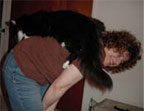 Dear
Cat Coach, Dear
Cat Coach,
I am very embarrassed to write
about my cat's problem. I am really hoping you can help us. My
cat Spike peed on my boyfriends head last night. Prior to last
night's episode, he's been peeing on just about anything my boyfriend
leaves around.
I've had Spike since he was
only 6 weeks old. There has never been anyone else living with
us, it's always been just Spike and me. Spike has been my buddy
for the last six years, his whole life. The only time we weren't
together was last year when I took a two week vacation. Spike's
jealously started last month when my boy friend moved in and
Spike peed in one of his shoes.
Can you please help us? My
boyfriend told me last night that unless something is done, I
have to choose between him and Spike.
Signed,
Desperate!
Dear Desperate!
It is easy to understand why
Spike is not welcoming your boyfriend into the house. Spike is
"resource guarding". And you're the resource he's guarding!
You have been his sole companion for all of his life. During
the last six years you have been the provider of everything Spike
needs and is accustomed to, including food, water, play and love.
Since your boyfriend moved in, the routine and consistency of
Spike's life has changed and Spike is no longer the center of
your attention.
The good news is that you won't
have to choose Spike over your boyfriend, or vice versa. Through
various activities, you and your boyfriend can influence Spike
to see him as another source of attention, food, play and love.
Start by having your boyfriend take over Spikes feeding. It is
important that he follows the same time schedule that you have
been keeping for feeding. If Spike enjoys being groomed, encourage
your boyfriend to gently groom him for a few minutes every day.
Keep in mind that everything your boyfriend does with Spike should
be enjoyable and pleasant for Spike. If Spike does not want to
be groomed, then your boyfriend shouldn't groom him. Play is
another tool to help bond Spike to your boyfriend. If possible,
he should play with Spike everyday, using a fishing pole toy.
Additionally, Spike will benefit
from both you and your boy friend clicker training him. For more
information on Clicker Training, either see the Animal Radio's
August 2006 Cat Coach Column about training cats http://animalradio.com/august2006.html
, or check out Karen Pryors web site at www.clickertraining.com
. Clicker Training will provide another fun way of helping Spike
to connect with your boyfriend and to reinforce his relationship
with you.
Don't forget your part in this!
It is important that you keep interacting with Spike everyday,
grooming, giving him treats, playing, clicker training and loving
him as much as possible. As Spike starts seeing your boyfriend
as someone who also provides for his needs, he should stop urinating
on your boyfriend and his belongings.
Hear The Cat Coach on Animal Radio
Network - LISTEN TO ANIMAL RADIO NETWORK NOW
Marilyn Krieger, CCBC is a
Certified Cat Behavior Consultant. She can be reached for phone
or on-site consultations to help solve cat behavior problems
either by e-mail marilyn@thecatcoach.com
or by phone: 650 780 9485. Additionally, Marilyn teaches cat
behavior classes and is available for speaking engagements. You
can find out more about The Cat Coach at http://www.thecatcoach.com Marilyn is certified
through The International Association of Animal Behavior Consultants.
Copyright July 2007 Marilyn Krieger, CCBC All Rights Reserved.
In Technecolor where available. Void where prohibited.
Animal
Radio® made possible by: SIMPLE
SOLUTION
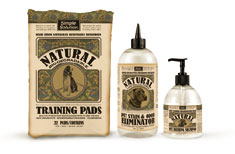 Earth conscious consumers now have an eco-friendly
choice in pet care. The Natural line of products by Simple Solution
is completely, 100% all-natural. The Biodegradable Training Pads,
used by many pet owners as an indoor potty, are 100% biodegradable even
by California's standards. They'll biodegrade faster than an
orange peel! The line also offers an all natural Pet Stain and
Odor Remover that's a great alternative to harsh chemicals found
in traditional household cleaners. Simple Solution® Natural
Pet Bathing Shampoo cleans and conditions with all natural ingredients
including, plant-based mild cleansers, Aloe Vera, Vitamin E and
Pro Vitamin B-5. Simple Solution Natural is based on a way of
life! Find Simple Solution at Petco, PetSmart or your local pet
retailer. www.simplesolution.com Earth conscious consumers now have an eco-friendly
choice in pet care. The Natural line of products by Simple Solution
is completely, 100% all-natural. The Biodegradable Training Pads,
used by many pet owners as an indoor potty, are 100% biodegradable even
by California's standards. They'll biodegrade faster than an
orange peel! The line also offers an all natural Pet Stain and
Odor Remover that's a great alternative to harsh chemicals found
in traditional household cleaners. Simple Solution® Natural
Pet Bathing Shampoo cleans and conditions with all natural ingredients
including, plant-based mild cleansers, Aloe Vera, Vitamin E and
Pro Vitamin B-5. Simple Solution Natural is based on a way of
life! Find Simple Solution at Petco, PetSmart or your local pet
retailer. www.simplesolution.com |
|
How
to Read Your Dog's Body Cues
Sarah Hodgson
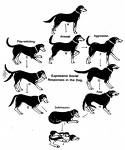 Before approaching an unfamiliar
dog or trying in vain to decipher your own dog's mood, watch
his body posture for clues to his personality and intentions.
The answers lie in the five key body points: Before approaching an unfamiliar
dog or trying in vain to decipher your own dog's mood, watch
his body posture for clues to his personality and intentions.
The answers lie in the five key body points:
- Ears: The position of a dog's
ears expresses his inner conviction. When a dog is feeling overwhelmed,
overpowered, or afraid, his ears will lie flat along his fur,
nearly disappearing in profile. When he is feeling confident,
they will relax into a naturally comfortable posture, and when
the dog is agitated or defensive, the ears will tilt forward
to reflect the seriousness of his state mind.
- Eyes: Though seemingly hard
to read at a distance, when taken collectively with other posturing
signals, the eyes provide invaluable insights. Direct eye contact
conveys confidence. When the other body points are relaxed, the
dog is trusting and ready for interaction. If the gaze is penetrating
and paired with frontal posturing, the dog may be defensive and
prepared to attack in order to defend a resource. A dog who avoids
eye contact is said to be fearful, panicked, or merely communicating
submissive respect.
- Mouth: Pair the actions of
a dog's muzzle with his other body cues and you can predict when
a dog is stressed, comfortable, or ready to bite. When a dog's
mouth is relaxed, closed or panting slightly, he is comfortable
in his surroundings and is usually approachable. If the lips
are pulled back into a seeming smile, the dog is offering a submissive
peace signal overshadowed with fear. A dog whose teeth are bared
is in a state of great emotional distress. Panicked, threatened,
or defending a resource, this dog will bite if pressed. In this
situation, calm withdrawal, avoiding all eye contact, is the
best course of action.
- Tail: A tail tucked under
the body conveys insecurity; if raised above the rump, it is
meant to make the dog appear larger and thus conveys a ready-for-action
state of mind. If the tail is level or slightly raised, the dog
is eager to interact with others and will put positive interaction
above a defensive response.
- Posture: Remember only this:
anything off-center conveys a strong emotional tide. If a dog
is leaning back, he is unsure, fearful, or conveying submission
to those around him. If his musculature, hair, or skeletal form
is up and/or forward, he is fully prepared to stand ground and
perhaps attack if his position is challenged.
Follow these quick tips to
understand any pup's persona!
Sarah Hodgson (Katonah, NY)
has taught dog training for 20 years and is the author of seven
dog training books, including Puppies For Dummies®, Miss
Sarah's Guide to Etiquette for Dogs & Their People, DogPerfect,
PuppyPerfect, and Teach Yourself VISUALLY™ Dog Training.
She has appeared on national television and radio programs to
promote her training methods and has served as a columnist for
the New York Times. The owner of Simply Sarah, a dog training
school and supply catalog based in Westchester, New York, she
also has a website, www.dogperfect.com.
Hodgson has a degree in psychology and animal behavior from the
State University of New York.
|
Animal Radio® made
possible by: Safe-Guard
 Get
ready for spring by protecting your dog and your family
against intestinal worm infections! Did you know that eggs
and larvae that infect dogs can survive in the environment for
months even in extreme winter weather conditions? And that
those same parasites can also infect humans? Why take chances?
Make intestinal deworming an important part of your dog's routine
health care with Safe-Guard® Canine Dewormer a safe
and effective way to eliminate and prevent the major intestinal
worms that can infect dogs all year round. Just sprinkle it on
your dog's food twice a year, for complete peace of mind! Get
ready for spring by protecting your dog and your family
against intestinal worm infections! Did you know that eggs
and larvae that infect dogs can survive in the environment for
months even in extreme winter weather conditions? And that
those same parasites can also infect humans? Why take chances?
Make intestinal deworming an important part of your dog's routine
health care with Safe-Guard® Canine Dewormer a safe
and effective way to eliminate and prevent the major intestinal
worms that can infect dogs all year round. Just sprinkle it on
your dog's food twice a year, for complete peace of mind!
Visit www.Safe-Guard.com for information on treating
and preventing intestinal worms.
|
|
 KEEPING
YOUR PET SAFE THIS SUMMER KEEPING
YOUR PET SAFE THIS SUMMER
Summer is here! That
means spending more time outdoors with your best friend (of the
four-legged variety). Pets911.com has the following tips to help
keep your pet safe this summer:
- DO NOT KEEP YOUR PET IN A
HOT CAR!!! Even a couple of minutes can be fatal.
- Always keep current tags on
your pet. The tag should include your pet's name, and your current
contact information an address and/or phone number with
area code. If you are moving or traveling this summer, remember
to update everything about your pet tags, microchips, vet
information, etc. If your pet gets lost while on a road trip,
alert your veterinarian, microchip company, local authorities,
local businesses, mail carriers, and delivery drivers. Report
your pet lost on PETS911.com and find the local shelters where
you can look for your pet. Stop at a local office store and have
lost posters created to hang in the vicinity of where you last
saw your pet.
- Keep your pet safely secured
inside if they are spooked by fireworks, thunderstorms, etc.
- Be careful with fertilizers
and plants. Many products and plants are hazardous, and even
fatal, for animals.
- Watch your pet around swimming
pools. If you have a pool, keep it fenced or covered when no
one is using it. Always supervise your pets around the pool.
As an added precaution (especially for in-ground pools), make
sure your pet knows how to get out of the pool if she falls in
accidentally. If possible, show her where the stairs are located
and how to swim to them.
- Do not let your pet ride in
the uncovered bed of your truck even tethered. She can
fall out with quick stops or curves and during accidents, or
be hit by debris.
- Get your pet on heartworm
and flea/tick prevention. Check with your veterinarian on how
to best protect your pet.
- Exercise your pet but take
caution to check temperatures both air and ground. Asphalt
can get hot enough to burn the pads on your pet's paws. Walk
your pet in the morning or evenings to avoid peak temperatures.
- Keep your pet supplied with
plenty of water. If you have outdoor bowls for your pets, use
plastic bowls as the sun can heat up metal bowls.
- Always watch your pet for
signs of heat stroke. If your pet is in danger, get him to a
veterinarian immediately. You can apply cool water to his body
or apply ice packs to his chest, face or neck areas only. Signs
of trouble include heavy panting, glazed eyes, a rapid pulse,
unsteadiness, vomiting, or a deep red or purple tongue.
Here's wishing you a safe and
enjoyable summer with your pets! For additional pet information,
visit www.Pets911.com.
Animal Radio®
is proud to partner with Pets911! Hear about the latest Pets911
activities on-air on Animal Radio®
Is
Pet Insurance Just for Senior Pets?
By Laura Bennett
Pet owners care deeply about
their canine or feline friend, and spend sizeable chunks of time
and cash of nutrition, exercise, furnishings and toys for their
pet. But have they thought through the financial responsibility
of owning a pet? Probably not, according to Laura Bennett, a
leading pet life and health actuary who recently started Embrace
Pet Insurance.
Bennett has published much
of her research on her pet insurance blog, where she regularly muses
on the pet industry. Bennett also answers pet health and insurance
questions from pet owners on her "Ask Laura" website
column.
"We researched what pet
owners need from an insurance policy and then designed our entire
company around those needs," says Bennett, who counts Barnes
and Lily, her two cats among her family members.
Here are some of the most important
pet insurance questions that pet owners often asks according
to Bennett.
When is the best time to
buy pet insurance for my dog or cat?
Laura Bennett: "The best time to buy pet insurance is when
your pet is younger but it is not the only time. The younger
your pet is when enrolled, the less chance there is of a pre-existing
condition preventing your pet from getting full coverage. But
just because your pet isn't a puppy or kitten any more doesn't
mean you can't get pet insurance. Even if your pet has a pre-existing
condition there's still a good chance you can get pet insurance
although the company may require a statement from your veterinarian
stating that a particular condition is cured."
Can I get pet insurance
for a senior dog or cat?
Laura Bennett: "Pet
insurance companies will usually issue a new policy to pets up
to 8 or 10 years old, sometimes older if your pet undergoes a
medical. You may also have to provide annual medical reports
to keep your pet insured. Your premium might be higher than that
of a younger pet, and some pre-existing conditions may be excluded.
The best thing is to enroll your pet when she's young and healthy
and avoid pre-existing conditions."
My pet is well now and I
look after her. Do I really need to buy pet insurance?
Laura Bennett: "This
is precisely when you should buy pet insurance, right when your
pet is well and has no pre-existing conditions. If you wait until
after your pet becomes sick, you are too late to cover that sickness.
No matter how well your pet is today, there is always a chance
that your pet will get sick or injured, which is when you actually
need protection."
Can I get coverage for routine
care such as vaccinations and spaying/neutering?
Laura Bennett: "It's
important to consider what insurance is for: to protect you against
unknown conditions that come without warning and can have a serious
impact on your family finances. That's when pet insurance has
the most positive impact. You can plan for routine care costs
and we recommend pet parents put aside money to cover these expenses,
not buy insurance to cover them. We opted to focus on pet insurance
for expensive, unpredictable situations that average people cannot
easily afford.
Embrace Pet Insurance
Agency LLC is a specialist insurance agency headquartered in
Mayfield Village, a suburb of Cleveland, Ohio. Embrace was founded
by Laura Bennett and Alex Krooglik, pet parents who also happen
to be insurance experts, and offers self-serve, customizable
pet health insurance for dogs and cats. Embrace Pet Insurance is not a
sponsor of Animal Radio®. Animal Radio® does not endorse
nor oppose these opinions. Anyone may submit articles for possible
inclusion in this newsletter by e-mailing
Animal Radio®
G'day from Downunder...
 Are
you getting on in years? Do you have a pet? Are
you getting on in years? Do you have a pet?
And while we don't wish this
on anybody of any age, what plans have you made for your pet
after you have 'passed on'?
Pets these days are living
longer due in part to better veterinary care and better nutrition.
And that dog, cat and particularly some birds (like parrots)
that you took in as a companion recently may very well out-live
you!
With dogs and cats living 15-20
years now and some species of parrots living to 70+ years owners
are making sure there is money and specific instructions as to
what happens to 'Polly' after the owner's death'.
It's not enough to just say
'oh our kids will take care of all that' because the kids may
not feel the same way as you do and find it easier to simply
surrender Fido, Fifi or Polly and imagine how confused your pet
will feel then!
Of course just like our pets,
people are living longer too and many of us may actually need
to go into a nursing home in our latter years (although we'll
be kicking & screaming we hasten to add!).
So what will happen to our
pets then? Another reason to plan for the future.
But it's not all doom and gloom
- out of Japan comes the story recently of a new nursing home
for dogs - old dogs! Apparently there's private rooms, TV's round-the-clock
monitoring by veterinarians and a bunch of playful puppies to
help keep the older dogs moving and keep them fit.
Yes for just $800 a month you
too can send your dog to the Soladi Care Home in Tochigi, eastern
Japan.
It actually sounds pretty good - a bit like that movie 'Caccoon!
The old dogs get specially
fortified food and we hear there's a heated pool, massage and
of course those young puppies to play with. Sounds like a lot
more fun than a boring old 'nursing home' eh? Maybe it's an idea
some well heeled entrepreneur could look into here!
Hope you continue to enjoy
what we offer on Pet Talk Radio! and of course Animal Radio Network™
Take care and hugs for your
pets
Brian & Kaye
Hear Pet Talk Radio! on Animal Radio Network
- LISTEN TO ANIMAL RADIO NETWORK NOW
- Check schedule for showtimes
| Search Animal Radio®
Network |
|
|
LISTEN TO ANIMAL RADIO NETWORK NOW
|
NETWORK PROGRAMS:
Animal Radio®
Animal Wise Radio
Pet
Talk Radio!
Talk
with Your Animals
Veterinary
Minute and Animal
Minute
Voice
of the Animal
|
Currently
On-Air
Animal
Radio® Network Full-time
channel
|
LISTEN TO ANIMAL RADIO NETWORK NOW
PLATFORMS
AND PLAYERS
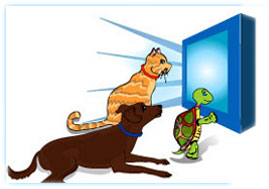 LISTEN AT WORK...all day long. Fresh animal programming 24/7.
Be sure to view our programming schedule to catch your
favorite show. LISTEN AT WORK...all day long. Fresh animal programming 24/7.
Be sure to view our programming schedule to catch your
favorite show.
 PET STORES, VETS, GROOMERS:
Would you like to broadcast Animal Radio Network in your store
or office? It's FREE and E-Z! Call 435.644.5992 to get set up.
Animal Radio Network is simulcast on the PetVision Network
throughout America to your store. PET STORES, VETS, GROOMERS:
Would you like to broadcast Animal Radio Network in your store
or office? It's FREE and E-Z! Call 435.644.5992 to get set up.
Animal Radio Network is simulcast on the PetVision Network
throughout America to your store.
  Listen to Animal
Radio Network's full-time Animal Channel ANYTIME on ANY CELL
PHONE, ANY PROVIDER. UpSnap now features Animal
Radio® Network LIVE 24/7. Listen to Animal
Radio Network's full-time Animal Channel ANYTIME on ANY CELL
PHONE, ANY PROVIDER. UpSnap now features Animal
Radio® Network LIVE 24/7.
 Get
live breaking news daily thanks to Simple Solution
NATURAL line of pet care products. Simply text "ANIMAL"
to 27627 to listen anytime FREE. (your provider's
standard rates apply). Learn more. Get
live breaking news daily thanks to Simple Solution
NATURAL line of pet care products. Simply text "ANIMAL"
to 27627 to listen anytime FREE. (your provider's
standard rates apply). Learn more.
WJTN BECOMES 94TH Animal Radio® AFFILIATE
 Animal
Radio Network™ is pleased to announce new radio affiliate
WJTN 1240 am Jamestown, New York to Animal Radio's growing
lineup. The Media One Group outlet airing Animal Radio®
Saturdays at 11am EST. Animal Radio® now airs on 94 multi-niche affiliates
including Los Angeles flagship KOST 103.5 FM. Animal
Radio Network™ is pleased to announce new radio affiliate
WJTN 1240 am Jamestown, New York to Animal Radio's growing
lineup. The Media One Group outlet airing Animal Radio®
Saturdays at 11am EST. Animal Radio® now airs on 94 multi-niche affiliates
including Los Angeles flagship KOST 103.5 FM.
Interested stations may acquire Animal Radio®
by calling 435.644.5992.
By Joy Turner
Thank
you...I appreciate having you in my life!
 Have
you ever wondered if someone you know really appreciates the
things you do or who you are? It's a fairly common question.
It's a question that can be asked by both humans and animals.
So many of us live with animals as our family. (I know - I have
10.) Have you taken the time to think about how much you appreciate
them or how grateful you are to have them in your life? Many
people don't. They just go along their way in their life until
the day their animal companion passes on and then they feel terrible
that they didn't do or say the things that were in their heart.
I know this because of the many calls I receive to talk with
animals (and humans) who have passed on to tell them how much
they are and were loved and how important they were in the people's
lives. It seems that it never occurred to the human to tell the
animal how appreciated they were or how grateful the person was
while the animal was still in their body. The grief the humans
feel can be greatly decreased by taking the time, even every
day, to tell your animal kids how much they mean to you. Saying
"I love you" is great. And, there is so much more that
can be said. Below is an example. Have
you ever wondered if someone you know really appreciates the
things you do or who you are? It's a fairly common question.
It's a question that can be asked by both humans and animals.
So many of us live with animals as our family. (I know - I have
10.) Have you taken the time to think about how much you appreciate
them or how grateful you are to have them in your life? Many
people don't. They just go along their way in their life until
the day their animal companion passes on and then they feel terrible
that they didn't do or say the things that were in their heart.
I know this because of the many calls I receive to talk with
animals (and humans) who have passed on to tell them how much
they are and were loved and how important they were in the people's
lives. It seems that it never occurred to the human to tell the
animal how appreciated they were or how grateful the person was
while the animal was still in their body. The grief the humans
feel can be greatly decreased by taking the time, even every
day, to tell your animal kids how much they mean to you. Saying
"I love you" is great. And, there is so much more that
can be said. Below is an example.
This is a friend's tribute to her 15 year old, extremely healthy,
long, haired tabby cat. She feels he has graced her life and
endured a lot. He came to her family when her human children
were small. She wants to thank him for his presence and gifts.
Lemonade,
Thank you for being willing to be named Lemonade. You are probably
the only cat in the Universe with that name. You were lovingly
named that by a 7 year old.
Thank you for putting up with your human sister and brother.
They dressed you up in doll clothes. They carried you around
like a stuffed toy. They at times tormented you and now are very
sorry for treating you that way.
Thank you for accepting your human dad. You were/are the man
of the house for many years. I explained to this person that
if Lemonade liked him, we could have a relationship. When you
climbed up on his lap and start sucking on his cotton shirt,
that was your way of saying, "He could stay."
Thank you for teaching all the new 4 legged family members the
rules of the house. Even at 15 years old, you are willing to
play with your little sister. She just adores you!
Thank you for teaching me how to trust. I was afraid to let people
and things out of my sight or grasp because they might not come
back. You gave me the lesson on a cold winter night that you
would be back. I stood outside in my bathrobe at Midnight trying
to coax you into the house. You spent the night outside and came
inside in the morning. Since then I have not worried about you
being gone for a night or two.
Thank you for understanding that we were busy building our new
house for the last 3 years. You and your brother were left home
almost every weekend. I know you missed me.
Thank you for telling me your thoughts about our new house. When
I brought you into the house for the first time, I heard you
say, "Wow!" When we sat at the water's edge, you said,
"There are lots of things to look at."
Thank you for moving with us to our new house out in the country.
Life is different here than in the city. You seem to be settling
in quite well even though you miss your other stomping grounds.
I enjoy when you and your brother go for a walk with me and the
dog.
Thank you for feeling safe with me. I would not let anyone hurt
you. Your purr shows you are feeling safe by becoming louder
every day.
Thank you for being in my life for the last 15 years. You have
been one of the consistent beings who has been loving me. It
is so great when you greet me as I pull into the driveway or
climb into my lap when I take the time to sit down.
In return for all your love, my wish for you is that you are
becoming who you truly were meant to be.
Lovingly, Your Mom
So in closing, maybe you might want to write a letter to your
animal kid whether they are alive or have passed to show your
appreciation and read it to them or take the time to tell them
how much you appreciate them and how grateful you are to have
them in your life. Go one step further and write a letter of
appreciation to a friend or family member and (e- or snail) mail
it. Every Being loves to be appreciated! You can never love anyone
too much and can never tell them enough how much you appreciate
them and how grateful you are to have them in your life. Personally,
I believe you should tell them this everyday as many times as
you can possibly fit into the day. Saying it and hearing it makes
both of you feel wonderful. This brings to mind my favorite saying
(see below).
Until next time, I'm Joy reminding you, you can never love your
animal companions too much. You can only love them, hopefully,
enough.
If you would like to
schedule a private session with Joy, call 425-867-1779 or go
to www.TalkWithYourAnimals.com.
If you are interested in being a caller on Talk with your Animals,
please email Martha@AnimalRadio.com
to make arrangements. Joy Turner is a regular Animal Radio®
correspondent. She can be heard daily. LISTEN TO ANIMAL RADIO NETWORK NOW
|
Animal Radio® made
possible by: American Anti-Vivisection
Society
 The
FDA has moved biotech companies one step closer to being able
to put milk and meat from cloned animals on your grocery store
shelves-without labels. Cloning seriously threatens animal welfare,
and you should have the choice to avoid these products! You can
help by calling on the FDA to keep cloned foods off of grocery
store shelves. Learn more at http://www.EndAnimalCloning.org The
FDA has moved biotech companies one step closer to being able
to put milk and meat from cloned animals on your grocery store
shelves-without labels. Cloning seriously threatens animal welfare,
and you should have the choice to avoid these products! You can
help by calling on the FDA to keep cloned foods off of grocery
store shelves. Learn more at http://www.EndAnimalCloning.org
Just because we can clone animals
for food, doesn't mean we should!
|
|
By Mike Fry
Proposed Bill Would Ban
Five Dog Breeds in Minnesota
 A
couple of weeks ago, two children were seriously mauled by two
dogs. The incident didn't make the news - probably because the
dogs involved were "Cocker Spaniels" and not "pit
bulls". A
couple of weeks ago, two children were seriously mauled by two
dogs. The incident didn't make the news - probably because the
dogs involved were "Cocker Spaniels" and not "pit
bulls".
It is a sad fact of life for
owners of Staffordshire Terriers, Staffordshire Bull Terriers,
and the other breeds that are sometimes referred to as "pit
bulls" that dog bites by these breeds are the only one that
seem to make headlines. In these days of "if it bleeds,
it leads" pseudo news reporting pit bulls are getting a
bum rap, because a "pit bull attack" sounds so much
more sensational than "cocker attack".
Even sadder is the fact that
some people fall for the sensational headlines, believing they
represent a complete picture of our world, and make decisions
based on them.
Case in point: On June 15,
Rep. John Lesch held a press conference
to announce that he plans to introduce a bill that will change
Minnesota State Law to outlaw five breeds of dogs, including
so-called "pit bulls", Chow Cows, Akitas, Rottweilers
and Wolf hybrids. Now, personally, I can understand some rationale
for wanting to outlaw Wolf hybrids. They are, after all, dangerous
exotic animals. Prohibiting them would be as easy as adding them
to the list of dangerous exotic animals already prohibited by
our dangerous exotics laws. However, the rest of the breeds on
this list are domesticated house pets that have been kept by
people as companions for millennia.
Of these breeds, the "pits"
are the one that seem to attract the most attention. So, I will
digress into a little reality-check for those unfamiliar with
the breeds, who may have bought into the media hype around them.
First, there is, technically,
no breed that is a "pit bull". That is a sort of catch-all
term used to describe a group of breeds. However, no one seems
to agree on which breeds make the cut.
Secondly, the breeds Staffordshire
Terriers and Staffordshire Bull Terriers, the breeds most often
called "pit bulls", consistently rate at the TOP of
the temperament testing charts. That means, by their nature,
so-called "pit bulls" are LESS likely to attack people
than most other breeds.
Thirdly, as the popularity
of "pit bull" breeds has increased in Minnesota, the
numbers of reported dog bites and attacks has actually decreased.
Lastly, there are countless
Rottweilers, "pit bulls", Chow Chows, Akitas, and mixes
of those breeds, that are wonderful, well-adjusted pets. Some
are working dogs helping police units. Some are therapy dogs.
Some of these breeds are 4-legged assistants to physically challenged
people.
Has Rep. Lesch really bought
all the media hype around these dogs? Is he really that uninformed?
Is it really his goal to have these animals taken away from their
families and destroyed? If it is, he is in for a real fight.
Related Links:
Troublemakers: What Pit Bulls Can Teach Us About
Profiling
YouTube Video - Denver's Pit Ban Bull
Results of Fatal Dog Attack Probe
Contact Rep John Lesch
Mike Fry, Executive Director
Animal
Ark No-Kill Shelter Co-Host Animal Wise Radio
Hear Animal Wise Radio on Animal Radio Network™-LISTEN TO ANIMAL RADIO NETWORK NOW
|
 Have you heard Animal Radio®
Network Lately? Have you heard Animal Radio®
Network Lately?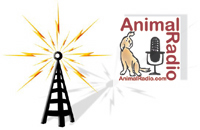
So many ways to listen!
Website: http://AnimalRadio.com
Toll-Free Studio Line is: 1.866.405.8405
- View
list of AM-FM RADIO STATIONS that air Animal Radio in your city.
Including
KOST 103.5 and KBIG 104.3 in Los Angeles
Website: http://www.AnimalRadio.com
Toll-Free Studio Line is: 1.866.405.8405
|
|
Animal Minute on
Animal Radio Network
with Britt Savage |
Woman
Dresses Roadkill
 Jessica
May, a 24-year old graduate art student at Southern Illinois-Edwardsville,
understands why some people don't "get" her art. Jessica
May, a 24-year old graduate art student at Southern Illinois-Edwardsville,
understands why some people don't "get" her art.
Recently Jessica has started
dressing roadkill. She has dressed possums in baby doll clothes
and painted their nails, applied makeup, and has even painted
a deer with gold paint.
Jessica doesn't find this offensive
and does it as a way of reminding drivers to slow down, causing
people to give animals more thought and bringing animals and
people closer to equality. While stating she is not an animal
rights activist; she hopes that if these animals were given human
characteristics, people will give more thought to them.
Britt Savage is a regular
Animal Radio® correspondent. She can be heard daily.
LISTEN TO ANIMAL RADIO NETWORK NOW
Voice of the Animal on Animal Radio Network
Rae Ann Kumelos Ph.D. |
Lobster: Much More than
a Cantankerous Crustacean
 Can
you guess what kind of animal the following names belong to?
Marbled mitten, regal slipper, hunchback locust, velvet fan,
unicorn, buffalo, musical furry? How about African spear, Arabian
whip, rough Spanish? Can
you guess what kind of animal the following names belong to?
Marbled mitten, regal slipper, hunchback locust, velvet fan,
unicorn, buffalo, musical furry? How about African spear, Arabian
whip, rough Spanish?
Give up? These are all types
of lobsters.
Although these fancifully named
lobsters live scattered about the Seven Seas, the most densely
populated lobster domain is the Gulf of Maine, where lobsters
are known by the more mundane name of humarus americanus, American
lobsters.
Lobsters do not feature prominently
in myths of various cultures, but take their place in a more
supporting role, as with the story of the beautiful Greek nymph,
Scylla, who was constantly being pursued by suitors, until a
jealous goddess turned her into a six-headed sea-monster and
the terror of sailors in the Aegean Sea. She did receive a small
consolation prize as Scylla is known as the goddess of lobsters.
In a happier story, Chinese myth holds Lobster in great delight
as the symbol of mirth.
In "The Secret Life of
Lobsters," author Trevor Corson writes about the lobstermen
that live in the year-round island communities on the Coast of
Maine, fishermen who have made the dangerous and difficult business
of trapping lobsters their family livelihood for generations,
and who have worked to establish rules that will protect both
the lobsters and their fishing heritage. A tale that Corson shares,
and one that is confirmed by my dear friend Annie, a chef in
Maine for many years, is of Barbie Lobster - an older, thus protected,
female lobster that some fisherman dressed in a Barbie outfit,
and who occasionally shows up in a trap, only to be dutifully
returned to the sea, her stylish outfit intact.
Scientists have discovered
that baby lobsters depend upon celestial cues to navigate. In
another nod to the heavens, the unique lens of the lobster's
eye is the inspiration for an X-ray vision space telescope called
Lobster ISS that will be mounted on the International Space
Station.
Their first year at Boston
Harbor, the Plymouth Pilgrims were grateful to have the lobsters
left by Native Americans, but in later years they preferred other
fare, considering the lobster lower-class. That changed as people
began to vacation in New England, and when, in the 1870's, railroad
cars packed with ice enabled live lobsters to be shipped from
the coast of Maine. William Randolph Hearst is credited with
the first order of lobsters shipped via rail for a dinner party
he was throwing in Colorado. Today tanks of live lobsters, their
claws bound for their Diaspora from their home in the Gulf of
Maine to landlocked points far to the west, are found in supermarkets
around the country. The poet laureate, Billy Collins, describes
these lobsters in tanks, "filled to the brim with their
copious tears."
An Irish saying goes, "It
is in the unexpected or neglected place that you will find the
lobster." I once shared a flight in a small commuter plane
with a lobster a woman was bringing back to California. As the
lobster's antennae poked out of the box, and his bound claws
shuffled against the cardboard, his copious tears fell not into
a tank of sea-water, but into an alien environment 20,000 feet
in the air.
Animals, especially a cantankerous
crustacean like the lobster, often tend to hold the projections
of what we want them to be. Some see the lobster as a delicious
meal, others as a legacy of livelihood. While some of us see
them simply as creatures whose unique and marvelous presence
is present alone.
Rae Ann Kumelos
is a regular Animal Radio® correspondent. She can be heard
daily. LISTEN TO ANIMAL RADIO NETWORK NOW
Visit us at http://www.voiceoftheanimal.com
to hear more stories and to order CD's of Voice of the Animal
programs. Copyright 2007 Voice of the Animal
Animal
Radio® is made possible by:
GET SERiOUS!
 - Extracts stains
& odors COMPLETELY
-in only 3 minutes! - Extracts the urine &
the pheromone -so pets aren't attracted back to re-mark! - Extracts stains
& odors COMPLETELY
-in only 3 minutes! - Extracts the urine &
the pheromone -so pets aren't attracted back to re-mark!
- Never leaves any "yellowing" behind (like
most enzyme-based cleaners) and even removes old locked-on
"yellowing" - left behind by other cleaners!
-1 bottle of GET SERiOUS! cleans as much
as 2 bottles of the competition because you only use 1/2 as much
as the others! - $AViNGS ! $AViNGS
! $AViNGS !
http://www.GetSeriousProducts.com |
|
 Email
your events to: root@AnimalRadio.com Email
your events to: root@AnimalRadio.com
Third Annual Dog-Gone Cat-a-Strophic
HUGS, SLURPS, and SLOBBERS
Sunday, July 15, 2007
Ventura County
Camarillo Animal Shelter
600 Aviation Drive
Camarillo, CA
10 a.m.-4 p.m.
 The Ventura County Camarillo Animal
Shelter in partnership with Rescue Me Incorporated are dedicated
to finding lifelong, loving homes for EACH of the shelter's homeless
pets during its Third Annual Dog-Gone Cat-a-Strophic HUGS, SLURPS,
and SLOBBERS event to be held on July 15th from 10am to 4pm at
the Camarillo Animal Shelter located at 600 Aviation Drive, Camarillo,
CA. The Ventura County Camarillo Animal
Shelter in partnership with Rescue Me Incorporated are dedicated
to finding lifelong, loving homes for EACH of the shelter's homeless
pets during its Third Annual Dog-Gone Cat-a-Strophic HUGS, SLURPS,
and SLOBBERS event to be held on July 15th from 10am to 4pm at
the Camarillo Animal Shelter located at 600 Aviation Drive, Camarillo,
CA.
Day of the event adopters take advantage of the on-site clinics
offering REDUCED RATE microchipping, REDUCED RATE rabies vaccinations,
and pet licensing. Each adopter will receive a FREE gift bag
and FREE vet visit for the new family member. Additionally, the
Camarillo Community Theater is offering 2 FREE tickets to the
production "The Diary of Anne Frank" to each adopter
that stops by their booth and presents adoption papers.
The fun filled day will include vendors, silent auctions, entertainment,
and special guests.
More animals are orphaned during the 4th of July holiday than
any other time of year. Come on out, join the fun and help us
find homes for ALL the animals! Only shelter animals in attendance
please.
Contact:
Joy Nadel, President/CEO
Rescue Me Incorporated
P.O. Box 385
Woodland Hills, CA 91365
818-999-2400
rescuemeincorporated@yahoo.com
WFCO, INC 5th International
Conference & Competitions
JULY 18-22, 2007
Quality Inn Hotel
701 8th Street
Greeley, Colorado 80631
 Hosted by WCFO Club, The Mile High Musical Freestylers Hosted by WCFO Club, The Mile High Musical Freestylers
FOCUS: This conference has been designed to expand the
attendee's knowledge of all aspects of the WCFO, INC Global canine
freestyle world. WCFO is about sharing and bonding with our dogs
and each other. Most canine freestylers have learned from sharing
ideas with each other, with newcomers and with our juniors. This
conference will impart a wealth of information to attendees that
they may add to their growing understanding of the subjective
creative sport of canine freestyle and K9 Dressage. This conference
is also designed to educate people who wish to become judges
of both canine freestyle and K9Dressage.
| ANIMAL
RADIO®
PRODUCT REVIEW for
July |
|
     (rated 4 and 1/2 out of 5 paws) (rated 4 and 1/2 out of 5 paws)
BugBand Insect Repellent
 Now
that the season of flies, gnats, fleas, ticks and mosquitoes
is fully upon us and our pets, we need protection! And, being
a pet guardian I want to protect me and my pets this summer without
harsh chemicals. Now
that the season of flies, gnats, fleas, ticks and mosquitoes
is fully upon us and our pets, we need protection! And, being
a pet guardian I want to protect me and my pets this summer without
harsh chemicals.
What I like best about these
BugBand products is that they contain no DEET, just Geranoiol
Oil, don't "stink" and are easy to use. I am a big
fan of the wristband, which I can place on my wrist, my belt
or even on my pet's collar. They are also great on outdoor areas,
such as my cattery. And, they can be used over and over by placing
them back in their reusable plastic pod which stores and seals
them between uses. And the bugs stayed away - what could be easier!
The BugBand Insect Repellent
comes in handy wristbands, towelettes and pump spray. They also
come in many different colors including dark green, light green,
blue, yellow, red, pink and glow-in-the-dark. Visit BugBand
to find a store near you - what are you waiting for!
Send products for review
on-air and in this newsletter to: Animal Radio® Network Product Reviews, 233
East 330 North, Kanab, Utah 84741. Products may not be returned.
|
| Small Dogs, Big Hearts with
Darlene Arden |
 ASK "THE DOG EXPERT" - by Darlene Arden, Certified Animal
Behavior Consultant ASK "THE DOG EXPERT" - by Darlene Arden, Certified Animal
Behavior Consultant
Q. My dog embarrassed me today.
I sort of hate to say it but I don't know what to do about it.
I was taking a walk with my dog and saw a friend so I stopped
to talk. After a couple of minutes, to my absolute horror, my
dog lifted his leg and peed on her! Why would he do that and
what can I do about it?
A. Ahhh, yes, I can certainly
understand why you were embarrassed. Dogs lift their legs and
"mark" for different reasons. Females will sometimes
lift their legs, too, much to the surprise of their owner. Mainly,
however, it is the males who will hike their leg on any vertical
surface. Why choose a human? Good question! If your dog knows
the person he could, indeed, be "marking" that individual
as his own. Or he may have been resource guarding you and wanted
to get the other person to leave. Or he may have felt nervous
around this individual and wanted to "mark" the person
in order to have his own scent there for comfort. I hope you
offered to clean and/or replace any spoiled clothing and/or shoes.
And don't yell at the dog. That won't help and will only add
to any insecurity that may have been present at that moment in
time.
"Ask the Dog Expert"
is a regular column by Darlene Arden. This month's column features
information found in her book, "The Angell Memorial Animal
Hospital Book of Wellness and Preventive Care for Dogs,"
(McGraw-Hill), which helps you, in concert with your veterinarian,
design a wellness program based on your dog, your lifestyle and
the place where you live, and "Small Dogs, Big Hearts,"
(Howell Book House), and the newly released, "Rover, Get
Off Her Leg!" Further information may also be found on her
website: www.darlenearden.com.
Copyright 2007 by Darlene Arden. All Rights Reserved.
Hear Darlene
Arden on Animal
Radio®
|
Animal Radio® made
possible by: FIDO FRIENDLY MAGAZINE
 Fido
Friendly magazine lists accommodations where you can stay with
your dog while traveling in the United States and Canada. Each
quarter, our editorial includes hotel, city and state reviews. Fido
Friendly magazine lists accommodations where you can stay with
your dog while traveling in the United States and Canada. Each
quarter, our editorial includes hotel, city and state reviews.
http://www.FidoFriendly.com
Don't miss Fido Friendly
Travel Talk exclusively on Animal Radio®
|
|
| ASK THE BIRD
FOLKS with Mike O'Connor |
 Plenty of Ways to Attract Birds Without
Seed: The High Price of Birdseed Plenty of Ways to Attract Birds Without
Seed: The High Price of Birdseed
Recently we received a question
from Carla, who was looking for an explanation about why birdseed
prices have gone up.
We explained that a sudden
lust for ethanol (which is made from corn) has driven the price
of corn way up. With the promise of better profits, the smart
farmers are planting more corn and thus are planting fewer acres
of sunflower seed, much to the chagrin of feeder birds everywhere.
You know things are bad when I start using words like "chagrin."
There is also another reason
why the cost of seed is going up. The people at Frito-Lay have
gotten tired of seeing so many fat Americans, so they are ditching
the saturated fat from their snack foods and are replacing it
with healthier sunflower oil. Both of these recent developments
have forced a surge in the price sunflower seed. The birds, of
course, aren't happy about this, but that is nothing compared
to the petulance I'll face when my customers find out that seed
prices have risen. You know things are bad when I start using
words like "petulance," because I don't even know what
it means.
So this week, in order to avoid
an outbreak of petulance, I'm going to offer a few suggestions
that will keep birds coming to your yard even if you decide to
boycott bird feeding or don't feel like getting a variable-rate
birdseed mortgage from the Money Store.
Water is an item that surprisingly
few people offer birds. And unless you are buying it from a vendor
at Fenway Park, it's pretty darn cheap. Yet each year we sell
thousands of bird feeders and only a few dozen birdbaths. That
surprises me because only a small percentage of North America's
birds come to our feeders, but all birds need to drink. Last
year I was thrilled when a Northern Waterthrush visited the little
water garden in my normally dull yard. (Yes, a waterthrush is
a real bird. Look it up.) Waterthrushes don't eat birdseed, but
as their name implies, they do like water. Without the water,
there would have been no surprise waterthrush visit.
A few weeks ago a lady walked
into our shop with a picture that she had taken of her birdbath.
The birdbath, which was nothing more than a one-inch-deep, flat
plastic dish, was bubbling over with blue, as there were at least
a dozen striking bluebirds drinking from it. Wow! So much for
my thrilling waterthrush story.
As the bluebird lady proved,
the water source doesn't have to be a water garden or some crazy-looking
Roman fountain with water squirting out of a lion's mouth. A
simple, shallow dish on the ground is fine. Remember, most birds
drink out of streams and puddles: very few of them prefer to
drink water squirting from a lion's mouth. And don't listen to
those paranoid freaks who think if you have a birdbath your yard
will be infested with mosquitoes that are just seething with
West Nile Virus and malaria. It takes weeks for mosquito eggs
to become adults. If you are too lazy to freshen-up your birdbath
every few days, then you probably deserve a case of malaria.
In the warmer months a hummingbird
feeder is fun to watch. I've been feeding hummingbirds since
the beginning of time and no matter when a hummer visits my feeder,
I stop what I'm doing and stare in amazement. The only food you
need is a cup of water (preferably not from Fenway), a quarter
cup of sugar and you are good to go.
A real wicked cheap way to
attract birds in the spring is to put out nesting material. An
old onion bag filled with short bits of string, yarn, or pet
fur can be a magnet for birds looking for low-cost building material.
Also, robins, swallows and phoebes all need a source of fresh
mud to build their sturdy nests with. A simple mud puddle is
a great way to draw those birds to your yard. The robins love
our house. We simply open the windows to the kids' bedrooms and
they find all the mud they need. And don't forget nest boxes.
A basic wooden birdhouse will keep birds returning year after
year, without any further investment, except for constant rate
increases from the cable company.
Yes, Carla, it looks as though
a bag of birdseed is going to cost a buck or two more this year
than it did last year. If you don't feel like dishing out the
extra cash, a few of the above suggestions will keep birds coming
to your yard without costing you much at all. Although, even
when seed prices are up, watching birds at a feeder is still
a cheap source of entertainment. It's certainly cheaper than
buying a bottle of water at Fenway Park. You could feed every
bird in town for the price of one of those.
Mike O'Connor is the owner
of the Bird Watcher's General Store on Cape Cod, which opened
in 1983 as one of the first stores in the United States dedictaed
solely to birding. His column, Ask the Bird Folks, appears weekly
in The Cape Codder, The Register, The Harwich Oracle, and The
Upper Cape Codder newspapers, and his writing was included in
the Best American Science and Nature Writing 2004. Copyright
2007 by Mike O'Connor. All Rights Reserved. http://www.BirdWatchersGeneralStore.com
| PAWS
UP FOR PETS with Arden
Moore |
Oh Behave, Kitty!
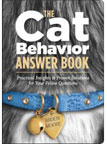 Face
the feline facts. Cats put the C in clever, the A in attitude,
the T in tenacious, and the S in "so what." Don't expect
them to apologize or to grovel leave that to those gotta-please
dogs. Cats pride themselves on being candid about what they want
when they want it. Face
the feline facts. Cats put the C in clever, the A in attitude,
the T in tenacious, and the S in "so what." Don't expect
them to apologize or to grovel leave that to those gotta-please
dogs. Cats pride themselves on being candid about what they want
when they want it.
I share this with you as the editor of Catnip, the monthly magazine
published in affiliation with Cummings School of Veterinary Medicine
at Tufts University and as the author of my latest pet
book, The Cat Behavior Answer Book (Storey Publishing). Like
many of you, I have been blessed and frustrated by
having a cat or two during my entire life.
I've spent a lot of time studying felines, including attending
national veterinary and animal behavior conferences. Knowledge
is power. When it comes to figuring out felines, you need to
nix the notion that you can use "canine psychology."
What may work on your lovable Labrador won't work on your attention-demanding
Abyssinian.
Not a day passes that someone doesn't ask me a cat question
even in public bathrooms and dog parks. People are truly puzzled
by these cunning, candid and clever creatures.
To remove some of this feline mystique, I am happy to share with
you an excerpt from my book, which consists of real questions
people pitched my way regarding their cats:
The Need to Knead
Q. Whenever I'm sitting down,
my cat will climb into my lap, circle around, plop down and busily
start to push her paws and claws up and down on my
legs. Why does she do this?
A. The feline ritual of rhythmically
pumping their paws up and down begins at birth. Newborns push
their paws around their mothers' nipples while they suckle to
hasten the flow of milk. Even after they are weaned, kittens
remember the happy feeling of a full belly that came with kneading
and nursing.
As adults, "making biscuits," as I like to call it,
brings them a sense of comfort. It is a way for cats to convey
joy and delight in having you in their lives. If you regularly
clip your cat's nails, you might avoid the pain of her nails
plunging into your lap.
Can't Stay Away
Q. My two cats often avoid
visitors who want to pet them, but will always march right over
to my friend who has terrible allergies! Why do cats seem to
make a beeline for the one person who wants to stay away from
them?
A. While some people enjoy
being rushed by admirers, cats exhibit their own brand of class.
Anything that moves quickly toward them is likely to be regarded
as a threat. So even if your Aunt Lilly simply adores your Persian
and wants to smother her in lipstick-coated kisses, your cat
wants no part of such overwhelming attention and flees the scene.
Cats like to call the shots and control introductions. It is
safer that way, not to mention more dignified. Your friend with
the allergies is doing his best to avoid making eye contact with
or physically touching your cats. In cat communications, he is
showing good feline manners. Your friend mistakenly thinks ignoring
your cats will make them not interested, but it has the opposite
effect. They regard him as non-threatening and friendly.
Silly as it sounds, ask your friend with allergies to clap his
hands and wave his arms when your cats approach him. You don't
want to terrify your cats, but these gestures may be just unwelcoming
enough for them to decide to keep their distance.
Dead Bird on My Bed!
Q. My cat, Lucy, uses the doggy
door to go into our fenced backyard. We have a bird feeder out
there, and every once in a while, I discover a dead bird on my
pillow. I almost faint at the sight. I want to scold Lucy, but
she looks at me with such pride. Why is she doing this?
A. Cats have novel ways of
showing that they love us and that they are worthy hunters. My
cat, Callie, once presented me with a huge dead rat like
you, I almost fainted. Whether these "gifts" are dead
birds, rats or crickets, our cats are displaying their hunting
instincts. We may keep their bowls full, but our domesticated
cats are not hunting out of hunger.
Some cats do bring their prey back home with plans to snack later,
but most just leave the carcass lying around. Experts in feline
behavior speculate that cats may bring us these "gifts"
in an effort to train us. Perhaps they have realized what lousy
hunters we are. Or maybe, they do it because they want our approval.
They can't go out and buy expensive gifts on credit cards, so
they hunt and offer us what they view as valued presents.
You can't snuff out Lucy's need to hunt, but you can give those
prey critters more of a fighting chance by putting a bell on
Lucy's collar. Also, offer Lucy some fake prey to stalk and chase
in your home, such as battery-operated toy mice that move erratically.
Happy hunting!
Animal
Radio® special
correspondent Arden Moore is the editor of Catnip, the national
award-winning monthly published in cooperation with Tufts University's
School of Veterinary Medicine and managing editor of Fido Friendly.
Arden has also authored 17 books on dogs and cats, including
her latest, The Cat Behavior Answer Book, (Storey Books, 2007).
To order any of her books or reach Arden, please visit her Web
site: http://www.ArdenMoore.com
|




 Actor Leslie Nielsen currently does
not have any pets, as he does a lot of traveling for his work
and doesn't feel it would be fair to a pet. But,
Actor Leslie Nielsen currently does
not have any pets, as he does a lot of traveling for his work
and doesn't feel it would be fair to a pet. But,  NEW
YORK-In light of the recent Menu Foods pet food recall, recent
speculation on whether certain pet foods may be contaminated
with acetaminophen has been spreading alarm among pet parents
and the public.
NEW
YORK-In light of the recent Menu Foods pet food recall, recent
speculation on whether certain pet foods may be contaminated
with acetaminophen has been spreading alarm among pet parents
and the public. 
 Since
Leslie is always on the go, he currently does not have any pets,
as he feels it wouldn't be fair to them. But, his one "Animal"
that he never leaves home without is his "Whoopee Cushion."
Hear him talk about some of his greatest moments with his "animal."
Since
Leslie is always on the go, he currently does not have any pets,
as he feels it wouldn't be fair to them. But, his one "Animal"
that he never leaves home without is his "Whoopee Cushion."
Hear him talk about some of his greatest moments with his "animal." Gary Burghoff and "Radar"
O'Reilly are synonymous with the kind, lovable yet kindred spirits
we can all remember with fondness. The role of "Radar"
was tailor-made for Gary because of his obvious love of animals
and his extraordinary personality. Remember Radar's zoo in M*A*S*H?
This theme originated from his real life Animal Rehabilitation
Clinic in Southern California where he nurtured and cared for
many species of birds such as the brown pelican, and many other
animals including opossums, grey squirrels, raccoons and abandoned
creatures needing Gary's special and tender-loving care. In fact
Gary, once known as the "Bird Man of Malibu", was licensed
by the State of California to care for wounded animals.
Gary Burghoff and "Radar"
O'Reilly are synonymous with the kind, lovable yet kindred spirits
we can all remember with fondness. The role of "Radar"
was tailor-made for Gary because of his obvious love of animals
and his extraordinary personality. Remember Radar's zoo in M*A*S*H?
This theme originated from his real life Animal Rehabilitation
Clinic in Southern California where he nurtured and cared for
many species of birds such as the brown pelican, and many other
animals including opossums, grey squirrels, raccoons and abandoned
creatures needing Gary's special and tender-loving care. In fact
Gary, once known as the "Bird Man of Malibu", was licensed
by the State of California to care for wounded animals. 
 Lucie Arnaz was an early
member of Actors and Others for Animals when they opened their
doors in 1971. The offspring of Lucille Ball and Desi Arnaz,
discusses her childhood pets and life with her famous parents.
Lucie Arnaz was an early
member of Actors and Others for Animals when they opened their
doors in 1971. The offspring of Lucille Ball and Desi Arnaz,
discusses her childhood pets and life with her famous parents. A
Baby Kangaroo Is Helping Residents of a Senior Citizens Community.
The residents of one senior center are getting a hopped-up dose
of medicine.
A
Baby Kangaroo Is Helping Residents of a Senior Citizens Community.
The residents of one senior center are getting a hopped-up dose
of medicine.

 Many
of you know legendary psychic Kenny Kingston, the original 'Psychic
to the Stars.'
Many
of you know legendary psychic Kenny Kingston, the original 'Psychic
to the Stars.' What started as
a class project for fourth-graders learning about handicapped
pets turned into a nationwide effort to help a bright-eyed dachshund
left partially paralyzed after an attack by angry teens.
What started as
a class project for fourth-graders learning about handicapped
pets turned into a nationwide effort to help a bright-eyed dachshund
left partially paralyzed after an attack by angry teens.
 When Pets Come Between Partners
When Pets Come Between Partners Mention
the word laser and immediately most people will start thinking
about futuristic space battles or late night rock concerts in
the planetarium. What could Star Wars, light sabers and Pink
Floyd possibly have to do with our pets?
Mention
the word laser and immediately most people will start thinking
about futuristic space battles or late night rock concerts in
the planetarium. What could Star Wars, light sabers and Pink
Floyd possibly have to do with our pets? Dear
Cat Coach,
Dear
Cat Coach, Earth conscious consumers now have an eco-friendly
choice in pet care. The Natural line of products by Simple Solution
is completely, 100% all-natural. The Biodegradable Training Pads,
used by many pet owners as an indoor potty, are 100% biodegradable even
by California's standards. They'll biodegrade faster than an
orange peel! The line also offers an all natural Pet Stain and
Odor Remover that's a great alternative to harsh chemicals found
in traditional household cleaners. Simple Solution® Natural
Pet Bathing Shampoo cleans and conditions with all natural ingredients
including, plant-based mild cleansers, Aloe Vera, Vitamin E and
Pro Vitamin B-5. Simple Solution Natural is based on a way of
life! Find Simple Solution at Petco, PetSmart or your local pet
retailer.
Earth conscious consumers now have an eco-friendly
choice in pet care. The Natural line of products by Simple Solution
is completely, 100% all-natural. The Biodegradable Training Pads,
used by many pet owners as an indoor potty, are 100% biodegradable even
by California's standards. They'll biodegrade faster than an
orange peel! The line also offers an all natural Pet Stain and
Odor Remover that's a great alternative to harsh chemicals found
in traditional household cleaners. Simple Solution® Natural
Pet Bathing Shampoo cleans and conditions with all natural ingredients
including, plant-based mild cleansers, Aloe Vera, Vitamin E and
Pro Vitamin B-5. Simple Solution Natural is based on a way of
life! Find Simple Solution at Petco, PetSmart or your local pet
retailer.  Before approaching an unfamiliar
dog or trying in vain to decipher your own dog's mood, watch
his body posture for clues to his personality and intentions.
The answers lie in the five key body points:
Before approaching an unfamiliar
dog or trying in vain to decipher your own dog's mood, watch
his body posture for clues to his personality and intentions.
The answers lie in the five key body points:
 Get
ready for spring by protecting your dog and your family
against intestinal worm infections! Did you know that eggs
and larvae that infect dogs can survive in the environment for
months even in extreme winter weather conditions? And that
those same parasites can also infect humans? Why take chances?
Make intestinal deworming an important part of your dog's routine
health care with Safe-Guard® Canine Dewormer a safe
and effective way to eliminate and prevent the major intestinal
worms that can infect dogs all year round. Just sprinkle it on
your dog's food twice a year, for complete peace of mind!
Get
ready for spring by protecting your dog and your family
against intestinal worm infections! Did you know that eggs
and larvae that infect dogs can survive in the environment for
months even in extreme winter weather conditions? And that
those same parasites can also infect humans? Why take chances?
Make intestinal deworming an important part of your dog's routine
health care with Safe-Guard® Canine Dewormer a safe
and effective way to eliminate and prevent the major intestinal
worms that can infect dogs all year round. Just sprinkle it on
your dog's food twice a year, for complete peace of mind! KEEPING
YOUR PET SAFE THIS SUMMER
KEEPING
YOUR PET SAFE THIS SUMMER
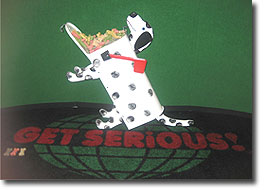 Guess how many bones
are in the mailbox and win the GET SERiOUS! SERiOUS-ly Cool Giveaway.
Guess how many bones
are in the mailbox and win the GET SERiOUS! SERiOUS-ly Cool Giveaway. Are
you getting on in years? Do you have a pet?
Are
you getting on in years? Do you have a pet? PET STORES, VETS, GROOMERS:
Would you like to broadcast Animal Radio Network in your store
or office? It's FREE and E-Z! Call 435.644.5992 to get set up.
Animal Radio Network is simulcast on the PetVision Network
throughout America to your store.
PET STORES, VETS, GROOMERS:
Would you like to broadcast Animal Radio Network in your store
or office? It's FREE and E-Z! Call 435.644.5992 to get set up.
Animal Radio Network is simulcast on the PetVision Network
throughout America to your store.
 Have
you ever wondered if someone you know really appreciates the
things you do or who you are? It's a fairly common question.
It's a question that can be asked by both humans and animals.
So many of us live with animals as our family. (I know - I have
10.) Have you taken the time to think about how much you appreciate
them or how grateful you are to have them in your life? Many
people don't. They just go along their way in their life until
the day their animal companion passes on and then they feel terrible
that they didn't do or say the things that were in their heart.
I know this because of the many calls I receive to talk with
animals (and humans) who have passed on to tell them how much
they are and were loved and how important they were in the people's
lives. It seems that it never occurred to the human to tell the
animal how appreciated they were or how grateful the person was
while the animal was still in their body. The grief the humans
feel can be greatly decreased by taking the time, even every
day, to tell your animal kids how much they mean to you. Saying
"I love you" is great. And, there is so much more that
can be said. Below is an example.
Have
you ever wondered if someone you know really appreciates the
things you do or who you are? It's a fairly common question.
It's a question that can be asked by both humans and animals.
So many of us live with animals as our family. (I know - I have
10.) Have you taken the time to think about how much you appreciate
them or how grateful you are to have them in your life? Many
people don't. They just go along their way in their life until
the day their animal companion passes on and then they feel terrible
that they didn't do or say the things that were in their heart.
I know this because of the many calls I receive to talk with
animals (and humans) who have passed on to tell them how much
they are and were loved and how important they were in the people's
lives. It seems that it never occurred to the human to tell the
animal how appreciated they were or how grateful the person was
while the animal was still in their body. The grief the humans
feel can be greatly decreased by taking the time, even every
day, to tell your animal kids how much they mean to you. Saying
"I love you" is great. And, there is so much more that
can be said. Below is an example. A
couple of weeks ago, two children were seriously mauled by two
dogs. The incident didn't make the news - probably because the
dogs involved were "Cocker Spaniels" and not "pit
bulls".
A
couple of weeks ago, two children were seriously mauled by two
dogs. The incident didn't make the news - probably because the
dogs involved were "Cocker Spaniels" and not "pit
bulls".
 Jessica
May, a 24-year old graduate art student at Southern Illinois-Edwardsville,
understands why some people don't "get" her art.
Jessica
May, a 24-year old graduate art student at Southern Illinois-Edwardsville,
understands why some people don't "get" her art.
 Can
you guess what kind of animal the following names belong to?
Marbled mitten, regal slipper, hunchback locust, velvet fan,
unicorn, buffalo, musical furry? How about African spear, Arabian
whip, rough Spanish?
Can
you guess what kind of animal the following names belong to?
Marbled mitten, regal slipper, hunchback locust, velvet fan,
unicorn, buffalo, musical furry? How about African spear, Arabian
whip, rough Spanish? Email
your events to:
Email
your events to:  Hosted by
Hosted by  Now
that the season of flies, gnats, fleas, ticks and mosquitoes
is fully upon us and our pets, we need protection! And, being
a pet guardian I want to protect me and my pets this summer without
harsh chemicals.
Now
that the season of flies, gnats, fleas, ticks and mosquitoes
is fully upon us and our pets, we need protection! And, being
a pet guardian I want to protect me and my pets this summer without
harsh chemicals.
 Fido
Friendly magazine lists accommodations where you can stay with
your dog while traveling in the United States and Canada. Each
quarter, our editorial includes hotel, city and state reviews.
Fido
Friendly magazine lists accommodations where you can stay with
your dog while traveling in the United States and Canada. Each
quarter, our editorial includes hotel, city and state reviews. Working Like Dogs: The Service
Dog Guidebook by Marcie Davis & Melissa Bunnell
Working Like Dogs: The Service
Dog Guidebook by Marcie Davis & Melissa Bunnell
 Face
the feline facts. Cats put the C in clever, the A in attitude,
the T in tenacious, and the S in "so what." Don't expect
them to apologize or to grovel leave that to those gotta-please
dogs. Cats pride themselves on being candid about what they want
when they want it.
Face
the feline facts. Cats put the C in clever, the A in attitude,
the T in tenacious, and the S in "so what." Don't expect
them to apologize or to grovel leave that to those gotta-please
dogs. Cats pride themselves on being candid about what they want
when they want it. FINAL POOP
FINAL POOP
 *
ADVERTISING OPPORTUNITIES for 2006 ANIMAL RADIO®
PROGRAMMING available. Call 435.644.5992. Animal Radio® Network, according to Arbitron radio
ratings, is the most-listened-to animal programming in the United
States. We have 250,000 Average-Quarter-Hour listeners - which
translates to an audience of two-million weekly in ninety-plus
cities. Our affiliate stations are top performers including KOST
103.5 and KBIG 104.3 in Los Angeles. Animal Radio® is the most concentrated radio audience
of targeted animal lovers anywhere! Please contact us for aggressive
and omnipotent branding and cultivating customer loyalty. Advertising
opportunities in this newsletter are also available. 38,000 subscribers
are reading this message right now!
*
ADVERTISING OPPORTUNITIES for 2006 ANIMAL RADIO®
PROGRAMMING available. Call 435.644.5992. Animal Radio® Network, according to Arbitron radio
ratings, is the most-listened-to animal programming in the United
States. We have 250,000 Average-Quarter-Hour listeners - which
translates to an audience of two-million weekly in ninety-plus
cities. Our affiliate stations are top performers including KOST
103.5 and KBIG 104.3 in Los Angeles. Animal Radio® is the most concentrated radio audience
of targeted animal lovers anywhere! Please contact us for aggressive
and omnipotent branding and cultivating customer loyalty. Advertising
opportunities in this newsletter are also available. 38,000 subscribers
are reading this message right now! *
If you're a RADIO PROGRAMMER and would like to air ANIMAL
RADIO® - call 435-644-5992 to get all the information
you need to begin broadcasting America's number one animal talk
show geared to listeners that like to have FUN! Animal Radio® programming is FREE for your station
- and delivered via Satellite (Jones and ABC/NY Starguide) or
Compact Disc or MP3 every week.
*
If you're a RADIO PROGRAMMER and would like to air ANIMAL
RADIO® - call 435-644-5992 to get all the information
you need to begin broadcasting America's number one animal talk
show geared to listeners that like to have FUN! Animal Radio® programming is FREE for your station
- and delivered via Satellite (Jones and ABC/NY Starguide) or
Compact Disc or MP3 every week.